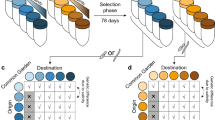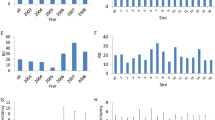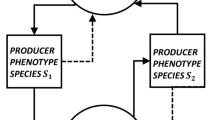Abstract
Random environmental fluctuations pose major threats to wild populations. As patterns of environmental noise are themselves altered by global change, there is a growing need to identify general mechanisms underlying their effects on population dynamics. This notably requires understanding and predicting population responses to the colour of environmental noise, in other words its temporal autocorrelation pattern. Here, we show experimentally that environmental autocorrelation has a large influence on population dynamics and extinction rates, which can be predicted accurately provided that a memory of past environment is accounted for. We exposed nearly 1,000 lines of the microalgae Dunaliella salina to randomly fluctuating salinity, with autocorrelation ranging from negative to highly positive. We found lower population growth, and twice as many extinctions, under lower autocorrelation. These responses closely matched predictions based on a tolerance curve with environmental memory, showing that non-genetic inheritance can be a major driver of population dynamics in randomly fluctuating environments.
This is a preview of subscription content, access via your institution
Access options
Access Nature and 54 other Nature Portfolio journals
Get Nature+, our best-value online-access subscription
$29.99 / 30 days
cancel any time
Subscribe to this journal
Receive 12 digital issues and online access to articles
$119.00 per year
only $9.92 per issue
Buy this article
- Purchase on Springer Link
- Instant access to full article PDF
Prices may be subject to local taxes which are calculated during checkout





Similar content being viewed by others
Data availability
The population dynamics and glycerol acquisition data that support the findings of this study are available from the Dryad digital repository50.
Code availability
R, C++ and Mathematica codes are available from the Dryad digital repository50.
References
Ovaskainen, O. & Meerson, B. Stochastic models of population extinction. Trends Ecol. Evol. 25, 643–652 (2010).
Lande, R., Engen, S. & Saether, B.-E. Stochastic Population Dynamics in Ecology and Conservation (Oxford Univ. Press, 2003).
Lewontin, R. C. & Cohen, D. On population growth in a randomly varying environment. Proc. Natl Acad. Sci. USA 62, 1056–1060 (1969).
Lawson, C. R., Vindenes, Y., Bailey, L. & van de Pol, M. Environmental variation and population responses to global change. Ecol. Lett. 18, 724–736 (2015).
Drake, J. M. Population effects of increased climate variation. Proc. R. Soc. B 272, 1823–1827 (2005).
García-Carreras, B. & Reuman, D. C. Are changes in the mean or variability of climate signals more important for long-term stochastic growth rate? PLoS ONE 8, e63974 (2013).
Tuljapurkar, S. D. Population Dynamics in Variable Environments (Springer, 1990).
Boer, G. J. Changes in interannual variability and decadal potential predictability under global warming. J. Clim. 22, 3098–3109 (2009).
Wigley, T. M. L., Smith, R. L. & Santer, B. D. Anthropogenic influence on the autocorrelation structure of hemispheric-mean temperatures. Science 282, 1676–1679 (1998).
Vasseur, D. A. & Yodzis, P. The color of environmental noise. Ecology 85, 1146–1152 (2004).
Sabo, J. L. & Post, D. M. Quantifying periodic, stochastic, and catastrophic environmental variation. Ecol. Monogr. 78, 19–40 (2008).
Chevin, L. M., Cotto, O. & Ashander, J. Stochastic evolutionary demography under a fluctuating optimum phenotype. Am. Nat. 190, 786–802 (2017).
Ripa, J. & Lundberg, P. Noise colour and the risk of population extinctions. Proc. R. Soc. B 263, 1751–1753 (1996).
Wichmann, M. C., Johst, K., Moloney, K. A., Wissel, C. & Jeltsch, F. Extinction risk in periodically fluctuating environments. Ecol. Model. 167, 221–231 (2003).
Heino, M., Ripa, J. & Kaitala, V. Extinction risk under coloured environmental noise. Ecography 23, 177–184 (2000).
Ruokolainen, L., Lindén, A., Kaitala, V. & Fowler, M. S. Ecological and evolutionary dynamics under coloured environmental variation. Trends Ecol. Evol. 24, 555–563 (2009).
Reed, T. E., Waples, R. S., Schindler, D. E., Hard, J. J. & Kinnison, M. T. Phenotypic plasticity and population viability: the importance of environmental predictability. Proc. R. Soc. B 277, 3391–3400 (2010).
Ashander, J., Chevin, L. M. & Baskett, M. L. Predicting evolutionary rescue via evolving plasticity in stochastic environments. Proc. R. Soc. B 283, 20161690 (2016).
Lande, R. & Shannon, S. The role of genetic variation in adaptation and population persistence in a changing environment. Evolution 50, 434–437 (1996).
Sæther, B. E. & Engen, S. Pattern of variation in avian population growth rates. Philos. Trans. R. Soc. B 357, 1185–1195 (2002).
Bjørkvoll, E. et al. Stochastic population dynamics and life-history variation in marine fish species. Am. Nat. 180, 372–387 (2012).
Engen, S. et al. Estimating the effect of temporally autocorrelated environments on the demography of density-independent age-structured populations. Methods Ecol. Evol. 4, 573–584 (2013).
Paniw, M., Ozgul, A. & Salguero-Gómez, R. Interactive life-history traits predict sensitivity of plants and animals to temporal autocorrelation. Ecol. Lett. 21, 275–286 (2018).
Pike, N., Tully, T., Haccou, P. & Ferrière, R. The effect of autocorrelation in environmental variability on the persistence of populations: an experimental test. Proc. R. Soc. B 271, 2143–2148 (2004).
Petchey, O. L. Environmental colour affects the dynamics of single-species populations. Proc. R. Soc. B 267, 747–754 (2000).
Laakso, J., Löytynoja, K. & Kaitala, V. Environmental noise and population dynamics of the ciliated protozoa Tetrahymena thermophila in aquatic microcosms. Oikos 102, 663–671 (2003).
Duncan, A. B., Gonzalez, A. & Kaltz, O. Stochastic environmental fluctuations drive epidemiology in experimental host-parasite metapopulations. Proc. R. Soc. B 280, 20131747 (2013).
Deutsch, C. A. et al. Impacts of climate warming on terrestrial ectotherms across latitude. Proc. Natl Acad. Sci. USA 105, 6668–6672 (2008).
Palumbi, S. R., Barshis, D. J., Traylor-Knowles, N. & Bay, R. A. Mechanisms of reef coral resistance to future climate change. Science 344, 895–898 (2014).
Calosi, P., Bilton, D. T. & Spicer, J. I. Thermal tolerance, acclimatory capacity and vulnerability to global climate change. Biol. Lett. 4, 99–102 (2008).
Lynch, M. & Gabriel, W. Environmental tolerance. Am. Nat. 129, 283–303 (1987).
Thomas, M. K., Kremer, C. T., Klausmeier, C. A. & Litchman, E. A global pattern of thermal adaptation in marine phytoplankton. Science 338, 1085–1088 (2012).
Hoffmann, A. A. Acclimation: increasing survival at a cost. Trends Ecol. Evol. 10, 1–2 (1995).
Nougué, O., Svendsen, N., Jabbour-Zahab, R., Lenormand, T. & Chevin, L. M. The ontogeny of tolerance curves: habitat quality vs. acclimation in a stressful environment. J. Anim. Ecol. 85, 1625–1635 (2016).
Lande, R. Evolution of phenotypic plasticity and environmental tolerance of a labile quantitative character in a fluctuating environment. J. Evol. Biol. 27, 866–875 (2014).
Proulx, S. R., Dey, S., Guzella, T. & Teotónio, H. How differing modes of transgenerational inheritance affect population viability in fluctuating environments. Ecol. Lett. 22, 1767–1775 (2019).
Engen, S., Lande, R. & Sæther, B.-E. A quantitative genetic model of r- and K -selection in a fluctuating population. Am. Nat. 181, 725–736 (2013).
Chevin, L. M., Lande, R. & Mace, G. M. Adaptation, plasticity, and extinction in a changing environment: towards a predictive theory. PLoS Biol. 8, e1000357 (2010).
Tuljapurkar, S. D. & Orzack, S. H. Population dynamics in variable environments I. Long-run growth rates and extinction. Theor. Popul. Biol. 18, 314–342 (1980).
Diserud, O. H. & Engen, S. A general and dynamic species abundance model, embracing the lognormal and the gamma Models. Am. Nat. 155, 497–511 (2000).
Ferguson, J. M., Carvalho, F., Murillo-García, O., Taper, M. L. & Ponciano, J. M. An updated perspective on the role of environmental autocorrelation in animal populations. Theor. Ecol. 9, 129–148 (2016).
García-Carreras, B. & Reuman, D. C. An empirical link between the spectral colour of climate and the spectral colour of field populations in the context of climate change. J. Anim. Ecol. 80, 1042–1048 (2011).
Knape, J. & de Valpine, P. Effects of weather and climate on the dynamics of animal population time series. Proc. R. Soc. B 278, 985–992 (2011).
Ben-Amotz, A. & Avron, M. The role of glycerol in the osmotic regulation of the halophilic alga Dunaliella parva. Plant Physiol. 51, 875–878 (1973).
Zidan, M. A., Hipkins, M. F. & Boney, A. D. Loss of intracellular glycerol from Dunaliella tertiolecta after decreasing the external salinity. J. Plant Physiol. 127, 461–469 (1987).
Leroi, A. M., Bennett, A. F. & Lenski, R. E. Temperature acclimation and competitive fitness: an experimental test of the beneficial acclimation assumption. Proc. Natl Acad. Sci. USA 91, 1917–1921 (1994).
Bonduriansky, R. & Day, T. Extended Heredity: A New Understanding of Inheritance and Evolution (Princeton Univ. Press, 2018).
Dennis, B., Ponciano, J. M., Lele, S. R., Taper, M. L. & Staples, D. F. Estimating density dependence, process noise, and observation error. Ecol. Monogr. 76, 323–341 (2006).
Kristensen, K., Nielsen, A., Berg, C. W., Skaug, H. & Bell, B. M. TMB: automatic differentiation and laplace approximation. J. Stat. Softw. 70, 1–21 (2016).
Rescan, M., Grulois, D., Ortega-Abboud, E. & Chevin, L.-M. Data and code from: Phenotypic memory drives population growth and extinction risk in a noisy environment. Dryad Digital Repository https://doi.org/10.5061/dryad.7d7wm37rc (2019).
Valpine, P. D. E. & Hastings, A. Fitting population models incorporating process noise and observation error. Ecol. Monogr. 72, 57–76 (2002).
Bates, D., Maechler, M., Bolker, B. & Walke, S. Fitting linear mixed-effects models using lme4. J. Stat. Softw. 67, 1–48 (2015).
Van Buuren, S. & Groothuis-Oudshoorn, K. MICE: multivariate imputation by chained equations in R. J. Stat. Softw. 45, 1–67 (2011).
Kassambara, A. & Kosinski, M. survminer: Drawing Survival Curves using ‘ggplot2’ (2018); http://rpkgs.datanovia.com/survminer/reference/ggsurvplot.html
Acknowledgements
This work was funded by the European Research Council under the European Union’s Horizon 2020 research and innovation programme (grant no. STG-678140-FluctEvol). We thank the MRI-IGMM platform for access to the cell sorter, the GenSeq platform (LaBEX CEMEB, Montpellier) for sequencing and O. Cotto, C.A. Klausmeier, R. Lande and J. Tufto for helpful feedback.
Author information
Authors and Affiliations
Contributions
L.-M.C. and M.R. designed the experiment. D.G. and M.R. conducted the population dynamics experiment. L.-M.C. and M.R. performed the statistical analysis. D.G. and M.R. extracted and amplified barcode genes of all lines and D.G., E.O.-A. and M.R. analysed the bioinformatics data.
Corresponding author
Ethics declarations
Competing interests
The authors declare no competing interests.
Additional information
Publisher’s note Springer Nature remains neutral with regard to jurisdictional claims in published maps and institutional affiliations.
Extended data
Extended Data Fig. 1 Population dynamics summary for each of the six ancestral genotypes.
(same colour as Fig. 2). a. Distribution of r: lines represent the estimated distribution fitted in the gamma model (solid lines) and histograms are based on the 3119 realized growth rates estimated from the population dynamics of each line, including residual deviation from the underlying model (gamma). b. Tolerance curves: lighter grey indicate higher growth rate, the thick bold line corresponds to the growth rate that allows overcoming the biweekly dilution (r = 0.542), and the thin bold line to r = 0.c. Estimated survival curves.
Extended Data Fig. 2 Population dynamics in constant salinities.
a. Time series of population sizes for all lines of ancestral genotype A in the 3 constant salinities (light blue: 0.8M, blue: 2.4M, dark blue: 3.2M – 5 replicates each) are plotted (shaded lines),together with the mean population size (solid line) ± standard deviation (dashed lines).Population sizes> 1,000 are plotted on the log scale and mean and standard deviation were estimated on the log scale, excluding extinct lines. Note that at 3.2M, the population size slowly decreases over time because its exponential growth slightly undercompensates the biweekly dilution. b. Distribution of population size in genotype A during the stationary phase (except at 3.2M where no stationary phase is reached), for all constant environmental treatments. Note the reduced variances and skewnesses as compared with the stochastic environments (Fig. 2). c. and d.: Growth rate (r) and carrying capacity (K) of all ancestral genetic backgrounds, estimated in the 3 constant salinities, with their standard errors. Salinity has a significant effect on K (p = 5.2.10-15, likelihood ratio test) but this was neglected in the population dynamic analysis in fluctuating environment because the biweekly 15% dilution implied that exponential growth was prevalent in our experiment (Extended Data Fig. 1).
Extended Data Fig. 3 Raw measurements.
a, b and c. Cytometer (Guava® EasyCyte) plots. Dunaliella shape and size do not allow distinction from debris but a gate can designed based on chlorophyll (red and yellow) autofluorescence. Dead cells were detectable after transfers from low to high salinity. They show an immediate decrease in red fluorescence, and are not taken into account when measuring population size. d and e. Regression between spectrometer measures (685nm fluorescence – 10722 points and 680nm optical density – 7332 points, see Supplementary Table 1 for details). Fluorescent values below 400 and optical density values below 0.01 (vertical lines) were discarded from the analysis and colours represent the day of each measure (from 0 (black) to 133 (light blue).
Extended Data Fig. 4 Tolerances curves of 3 clones from BC genotype under autocorrelation 0.
We measured exponential growth (starting 3 independent replicates from 5000 cells and measuring population size after 3 days) in 75 previous x current cross salinities ranging from 0.1 to 4.7M. Raw growth rate ranging from -1.5 (black) to 1 (light grey) were measured (dots) and bivariate tolerance curves (colour and curves) were fitted using equation 12 (see Method section). Clones displayed similar plasticity as found in the total population (Extended Data Fig. 1, genotype BC).
Extended Data Fig. 5 Salinity distribution in the stochastic treatments.
a. Salinity time series of 10 of the 39 independent lines for each of the four autocorrelation treatments (same colours as Fig. 2). b. Distribution of salinities in the 39 independent salinity series experienced by the six ancestral genetic background in the four autocorrelation treatments. Note that truncation of salinities that could not be reached with our dilution level did not much affect the final distribution of salinities in our treatments, which was similar to the Gaussian expectation in the absence of truncation (line).
Extended Data Fig. 6 Comparison between population sizes fitted in the state–space model including an autocorrelated normal (x) or a gamma (y) distribution of the intrinsic growth rate r.
The same colours and symbols as Fig. 2 were used to represent autocorrelation and genotypes of the 22497 data points.
Supplementary information
Supplementary Information
Supplementary text, references and Tables 1 and 2.
Rights and permissions
About this article
Cite this article
Rescan, M., Grulois, D., Ortega-Aboud, E. et al. Phenotypic memory drives population growth and extinction risk in a noisy environment. Nat Ecol Evol 4, 193–201 (2020). https://doi.org/10.1038/s41559-019-1089-6
Received:
Accepted:
Published:
Issue Date:
DOI: https://doi.org/10.1038/s41559-019-1089-6



